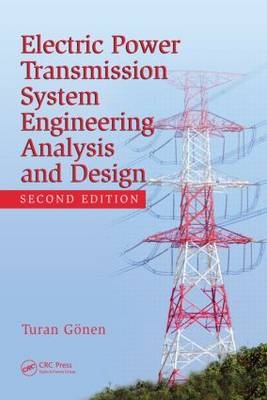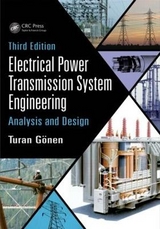
Electrical Power Transmission System Engineering
Crc Press Inc (Verlag)
978-1-4398-0254-0 (ISBN)
- Titel erscheint in neuer Auflage
- Artikel merken
Although many textbooks deal with a broad range of topics in the power system area of electrical engineering, few are written specifically for an in-depth study of modern electric power transmission.
Drawing from the author’s 31 years of teaching and power industry experience, in the U.S. and abroad, Electrical Power Transmission System Engineering: Analysis and Design, Second Edition provides a wide-ranging exploration of modern power transmission engineering. This self-contained text includes ample numerical examples and problems, and makes a special effort to familiarize readers with vocabulary and symbols used in the industry.
Provides essential impedance tables and templates for placing and locating structures
Divided into two sections—electrical and mechanical design and analysis—this book covers a broad spectrum of topics. These range from transmission system planning and in-depth analysis of balanced and unbalanced faults, to construction of overhead lines and factors affecting transmission line route selection. The text includes three new chapters and numerous additional sections dealing with new topics, and it also reviews methods for allocating transmission line fixed charges among joint users.
Uniquely comprehensive, and written as a self-tutorial for practicing engineers or students, this book covers electrical and mechanical design with equal detail. It supplies everything required for a solid understanding of transmission system engineering.
Turan Gönen is Professor of Electrical Engineering at California State University, Sacramento. He holds a BS and MS in Electrical Engineering from Istanbul Technical College (1964 and 1966, respectively), and a Ph.D. in Electrical Engineering from Iowa State University (1975). Dr. Gönen also received an MS in Industrial Engineering (1973) and a Ph.D. co-major in Industrial Engineering (1978) from Iowa State University, and a Master of Business Administration (MBA) degree from the University of Oklahoma (1980). Professor Gönen is the Director of the Electrical Power Educational Institute at California State University, Sacramento. Previously, Dr. Gönen was Professor of Electrical Engineering and Director of the Energy Systems and Resources Program at the University of Missouri-Columbia. Professor Gönen also held teaching positions at the University of Missouri-Rolla, the University of Oklahoma, Iowa State University, Florida International University and Ankara Technical College. He has taught electrical electric power engineering for over thirty one years. Dr. Gönen also has a strong background in power industry; for eight years he worked as a design engineer in numerous companies both in the United States and abroad. He has served as a consultant for the United Nations Industrial Development Organization (UNIDO), Aramco, Black & Veatch Consultant Engineers, and the public utility industry. Professor Gönen has written over 100 technical papers as well as four other books: Modern Power System Analysis, Electric Power Distribution System Engineering, Electrical Machines, and Engineering Economy for Engineering Managers. Turan Gönen is a Fellow of the Institute of Electrical and Electronics Engineers and a Senior Member of the Institute of Industrial Engineers. He served on several Committees and Working Groups of the IEEE Power Engineering Society, and he is a member of numerous honor societies including Sigma Xi, Phi Kappa Phi, Eta Kappa Nu, and Tau Alpha Pi. Professor Gönen received the Outstanding Teacher Award at CSUS in 1997.
Transmission System Planning
Aging Transmission System
Benefits of Transmission
Power Pools
Transmission Planning
Traditional Transmission System Planning Techniques
Models Used in Transmission System Planning
Transmission Route Identification and Selection
Traditional Transmission System Expansion Planning
Traditional Concerns for Transmission System Planning
New Technical Challenges
Transmission Planning after Open Access
Possible Future Actions by Ferc
Transmission Line Structures and Equipment
The Decision Process to Build a Transmission Line
Design Tradeoffs
Traditional Line Design Practice
Environmental Impact of Transmission Lines
Transmission Line Structures
Subtransmission Lines
Transmission Substations
Sf6-Insulated Substations
Transmission Line Conductors
Insulators
Substation Grounding
Transmission Line Grounds
Types of Grounding
Transformer Connections
Autotransformers in Transmission Substations
Transformer Selection
Transformer Classifications
Fundamental Concepts
Factors Affecting Transmission Growth
Stability Considerations
Power Transmission Capability of a Transmission Line
Surge Impedance and Surge Impedance Loading of a Transmission Line
Loadability Curves
Compensation
Shunt Compensation
Series Compensation
Static Var Control
Static Var Systems
Thyristor-Controlled Series Compensator
Static Compensator
Thyristor-Controlled Braking Resistor
Superconducting Magnetic Energy Systems
Subsynchronous Resonance
The Use of Static Compensation to Prevent Voltage Collapse or Instability
Energy Management System
Supervisory Control and Data Acquisition
Advanced Scada Concepts
Six-Phase Transmission Lines
Overhead Power Transmission
Short Transmission Lines (up to 50 mi, or 80 km)
Medium-Length Transmission Lines (up to 150 mi, or 240 km)
Long Transmission Lines (Above 150 mi, or 240 km
General Circuit Constants
Bundled Conductors
Effect of Ground on Capacitance of Three-Phase Lines
Environmental Effects of Overhead Transmission Lines
Underground Power Transmission and Gas-Insulated Transmission Lines
Underground Cables
Underground Cable Installation Techniques
Electrical Characteristics of Insulated Cables
Sheath Currents in Cables
Positive- and Negative-Sequence Reactances
Zero-Sequence Resistance and Reactance
Shunt Capacitive Reactance
Current-Carrying Capacity of Cables
Calculation of Impedances of Cables in Parallel
Ehv Underground Cable Transmission
Gas-Insulated Transmission Lines
Location of Faults in Underground Cables
Direct-Current Power Transmission
Overhead High-Voltage DC Transmission
Comparison of Power Transmission Capacity of High-Voltage DC and AC
High Voltage DC Transmission Line Insulation
Three-Phase Bridge Converter
Rectification
Per-Unit Systems and Normalizing
Inversion
Multibridge (B-Bridge) Converter Stations
Per-Unit Representation of B-Bridge Converter Stations
Operation of Direct-Current Transmission Link
Stability of Control
The Use of "Facts" and HVDC to Solve Bottleneck Problems in the Transmission Networks
High-Voltage Power Electronic Substations
Additional Commends on HVDC Converter Stations
Transient Overvoltages and Insulation Coordination
Traveling Waves
Effects of Line Terminations
Junction of Two Lines
Junction of Several Lines
Termination in Capacitance and Inductance
Bewley Lattice Diagram
Surge Attenuation and Distortion
Traveling Waves on Three-Phase Lines
Lightning and Lightning Surges
Shielding Failures of Transmission Lines
Lightning Performance of UHV Lines
Stroke Current Magnitude
Shielding Design Methods
Switching and Switching Surges
Overvoltage Protection
Insulation Coordination
Geomagnetic Disturbances and Their Effects on Power System Operations
Limiting Factors for Extra-High and Ultrahigh Voltage Transmission: Corona, Radio Noise, and Audible Noise
Corona
Radio Noise
Audible Noise (AN)
Conductor Size Selection
Symmetrical Components and Fault Analysis
Symmetrical Components
The Operator a
Resolution of Three-Phase Unbalanced System of Phasors into its Symmetrical Components
Power in Symmetrical Components
Sequence Impedances of Transmission Lines
Sequence Capacitances of Transmission Line
Sequence Impedances of Synchronous Machines
Zero-Sequence Networks
Sequence Impedances of Transformers
Analysis of Unbalanced Faults
Shunt Faults
Series Faults
Determination of Sequence Network Equivalents for Series Faults
System Grounding
Elimination of SLG Fault Current by using Peterson Coils
Six-Phase Systems
Protective Equipment and Transmission System Protection
Interruption of Fault Current
High Voltage Circuit Breakers
Circuit Breaker Selection
Disconnect Switches
Load-Break Switches
Switchgear
The Purpose of Transmission Line Protection
Design Criteria for Transmission Line Protection
Zones of Protection
Primary and Backup Protection
Reclosing
Typical Relays Used on Transmission Lines
Computer Applications in Protective Relaying
Transmission System Reliability
National Electric Reliability Council
Index of Reliability
Section 209 of Purpa of 1978
Basic Probability Theory
Combinational Analysis
Probability Distributions
Basic Reliability Concepts
Systems with Repairable Components
Reliability Evaluation of Complex Systems
Markov Processes
Transmission System Reliability Methods
Construction of Overhead Lines
Factors Affecting Mechanical Design of Overhead Lines
Character of Line Route
Right-of-Way
Mechanical Loading
Required Clearances
Type of Supporting Structures
Mechanical Calculations
Grade of Construction
Line Conductors
Insulator Types
Joint Use by Other Utilities
Conductor Vibration
Conductor Motion Caused by Fault Currents
Sag and Tension Analysis
Effect of Change in Temperature
Line Sag and Tension Calculations
Spans of Unequal Length: Ruling Span
Effects of Ice and Wind Loading
National Electric Safety Code
Line Location
Appendices
| Erscheint lt. Verlag | 29.5.2009 |
|---|---|
| Zusatzinfo | over 1800 equations; 78 Tables, black and white; 397 Illustrations, black and white |
| Verlagsort | Bosa Roca |
| Sprache | englisch |
| Maße | 178 x 254 mm |
| Gewicht | 1701 g |
| Themenwelt | Technik ► Elektrotechnik / Energietechnik |
| ISBN-10 | 1-4398-0254-8 / 1439802548 |
| ISBN-13 | 978-1-4398-0254-0 / 9781439802540 |
| Zustand | Neuware |
| Haben Sie eine Frage zum Produkt? |
aus dem Bereich



